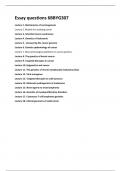Essay questions 6BBYG307
Lecture 1. Mechanisms of carcinogenesis
Lecture 2. Models for studying cancer
Lecture 3. Inherited cancer syndromes
Lecture 4. Genetics of leukaemia
Lecture 5. Uncovering the cancer genome
Lecture 6. Genetic epidemiology of cancer
Lecture 7. New technological platforms in cancer genetics
Lecture 8. The genetics of breast cancer
Lecture 9. Targeted therapies in cancer
Lecture 10. Epigenetics and cancer
Lecture 11. The genetics of chronic lymphocytic leukaemia (CLL)
Lecture 12. Viral oncogenes
Lecture 13. Targeted therapies in solid tumours
Lecture 14. Molecular pathogenesis of melanoma
Lecture 15. Novel agents to treat lymphoma
Lecture 16. Genetics of myeloproliferative disorders
Lecture 17. Cutaneous T cell lymphoma genetics
Lecture 18. Clinical genomics of solid cancer
, Lecture 1. Mechanisms of carcinogenesis
The lifetime risk for any individual to develop cancer is 50%. 38% of these cases are
preventable, including melanoma, lung cancer and breast cancer. 15% of cancer cases are
related to smoking and 3%-10% are related to obesity. Predisposing factors to cancer include
toxins, inflammation and immunity, genetic mutations, hormones and ethnicity. Risk factors
include occupation, family and medical history, age, gender, ethnicity, genes, immunity and
lifestyle.
There are nine hallmarks of cancers. These are sustained proliferation, resistance to cell
death, replicative immortality, dysregulated differentiation, invasion and metastasis,
angiogenesis, inflammation that promotes tumour growth, genomic instability and mutation,
and dysregulated metabolic states. Whiteman and Wilson (2016) investigated cancers
attributable to potentially modifying factors like tobacco smoke, alcohol and obesity. The
population attributable fraction was calculated to quantify how many cancers might be
avoided if exposure to causal factors di not occur. They found that the number of upper-
digestive tract cancers attributable to tobacco smoking was consistently high, with the PAF
for cancers attributable to tobacco and alcohol being higher in men.
Toxins are absorbed in the mucosa and tend to damage DNA. If this damage is extensive, cells
will be unable to repair it, causing mutations. These mutations may occur in tumour
suppressor genes, causing uncontrolled tumour growth. Mutations may also occur in proto-
oncogenes which transform into oncogenes, driving cellular growth. Alcohol is a toxin and its
direct inflammatory effect increases cancer risk. It also acts as a solvent to tobacco, promoting
the absorption of carcinogens. Factors like elevated oestrogen and adiposity can affect
alcohol absorption.
Asbestos and shift work are significantly associated with carcinogens. Asbestos has a 40-50
year latency and causes inflammatory reactions in the lung as well as the release of pro-
inflammatory cytokines like IL-1beta. Asbestos kills tissue and sets up a chronic inflammatory
environment in the lung. This will damage DNA, setting up a positive feedback of
inflammatory reaction. As mutations continue to accumulate over time, cancer develops.




